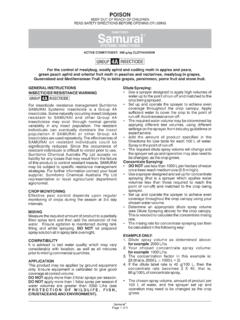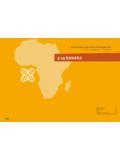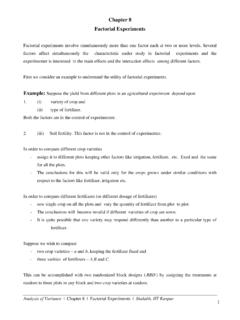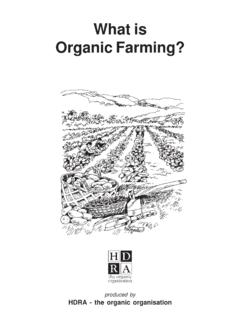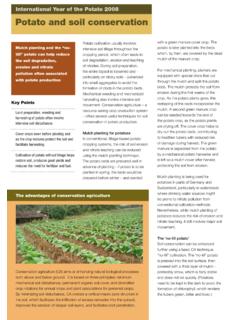Transcription of Talstar 250 Insecticide/Miticide draft label - Pest Genie
1 Astral 100EC Approved: 30 July 2012 Page: 1 of 12 POISON KEEP OUT OF REACH OF CHILDREN READ SAFETY DIRECTIONS BEFORE OPENING OR USING ASTRAL 100EC Insecticide/Miticide ACTIVE CONSTITUENT: 100g/L BIFENTHRIN SOLVENT: 756g/L HYDROCARBON LIQUID GROUP 3A insecticide Controls insect pests and mites of apricots, bananas, barley, canola, citrus, clover, cotton, cucurbits, faba beans, field peas, grapes, lucerne, lucerne seed crops, lupins, navy beans, nectarines, peaches, pears, plums, poppies, subterranean clover, sugarcane, tomatoes and wheat as specified in Directions for Use table.. Contents: 1-20, 110, 200 and 1000 Litres Crop Care Australasia Pty Ltd, Unit 15/16 Metroplex Avenue, Murarrie Qld 4172 Astral 100EC Approved: 30 July 2012 Page: 2 of 12 DIRECTIONS FOR USE Restraints DO NOT use as a foliar spray in banana plantations and orchards where mite predators or other beneficials are established and providing effective mite control and/or other pest control.
2 DO NOT apply as a foliar treatment if rainfall is expected before spray deposits dry on leaf surfaces. DO NOT apply to bananas by aircraft. DO NOT use on cucurbit crops grown in covered or protected situations such as glasshouses, greenhouses or plastic tunnels. CROP PEST STATE RATE WHP CRITICAL COMMENTS Bananas Banana weevil borer (Cosmopolites sordidus) Banana rust thrips (Chaetanaphothrips signipennis) Qld, NSW, WA & NT only Seasonal Program Stool Treatment Method 250-330mL/100L twice per year OR 660mL/100L once per year Band Treatment Method 250mL/100L twice per year Monitoring Program Stool Treatment Method 330mL/100L Band Treatment Method 250mL/100L 1 day Seasonal Program Twice per year Timing Apply in October/November (spring/early summer) and March/April (late summer/autumn).
3 Use the higher rate (concentration) when borer pressure or damage is high. Once per year Timing Apply in October/November OR March/April. Monitoring Program Monitor weevil borer populations carefully by trap counts and/or corm damage ratings, beginning in September when pest activity is on the increase and continue until April. Apply treatment when banana weevil borers reach or exceed acceptable threshold levels. Monitor borer control after application and re-treat as required. Banana weevil borer: Application should be made after rain or irrigation during periods of high adult borer activity. Banana rust thrips: Application against banana weevil borer will give coincident rust thrips control, particularly when application is made when thrips activity is on the increase usually beginning September and into the summer months.
4 Application Method Stool Treatment Application Remove trash from the base of stools and apply 500 - 750mL of spray solution to each stool, depending on stool size. Treat the bottom 30cm of each stool as well as the soil in a 30cm band around each stool, ensuring thorough treatment of both butt(s) and follower(s). Use the lower spray volume of 500mL on small stools less than 50cm across the entire base. Band Treatment Application Apply as a band application with a side delivery boom and offset nozzles on both sides of the row with the spray pattern positioned to spray 30cm of soil on either side of the row and 30cm in height. Aim to apply a total spray volume of 1L/stool area.
5 For single sucker row configurations apply 28L of solution per 100 metres of row in a band wide on each side of the row overlapping in the centre. For double sucker row configurations apply 56L of solution per 100 metres of row in a band 1m wide on each side of the double row with the spray pattern overlapping between the rows. Strawberry spider mite (Tetranychus lambi) Qld & WA only 40mL/100L 8 days Monitor mite population on old leaves particularly during hot dry conditions. Apply ASTRAL 100EC as a preventative rather than a curative treatment before damage occurs, and before mite numbers build up to damaging levels.
6 Follow up applications may be required at 10 - 14 day intervals. Thorough coverage of the lower leaf surface is essential to ensure good control. Use a total spray volume of 300 500L/ha. Astral 100EC Approved: 30 July 2012 CROP PEST STATE RATE WHP CRITICAL COMMENTS Cotton Native budworm (Helicoverpa punctigera) Cotton bollworm (Helicoverpa armigera) Two spotted mite (Tetranychus urticae) Green mirid (Creontiades dilutus) Apple dimpling bug (Campylomma liebknechti) Qld, NSW & WA only 600-800mL/ha 14 days (H) DO NOT GRAZE OR CUT FOR STOCK-FEED. DO NOT FEED COTTON TRASH TO LIVE-STOCK. Apply as indicated by field checks. Use the higher rate when pest pressure is high, conditions favour pest development and when increased residual protection is required.
7 Budworm and Bollworm: Applications should be timed to coincide with egg hatch and when small larvae up to 5mm are present. Do not apply this product to Helicoverpa (= Heliothis) armigera larvae larger than 5mm in length. Two spotted mite: Applications against Helicoverpa spp will give good control of coincident two spotted mite, particularly when applied on low mite populations (around 10% leaf infestation). If conditions continue to favour mite development a second application may be required 14 - 20 days later. Green mirid & Apple dimpling bug: Apply at recommended threshold levels as indicated by field checks. Use the higher rate for increased pest pressure and longer residual protection.
8 Silverleaf whitefly (Bemesia tabaci) Biotype B 800mL/ha Apply as indicated by field checks before populations reach damaging levels. Thorough coverage of the crop canopy is essential. The adult stage of silverleaf whitefly should be targeted. Do not spray crops with a high population of the juvenile stages of silverleaf whitefly unless using with another insecticide that is effective against these stages. Use ASTRAL 100EC in rotation with insecticides from at least 2 other insecticide groups that are registered or permitted for use against silverleaf whitefly on cotton. Do not apply more than 2 applications of ASTRAL 100EC per crop.
9 If an approved Resistance Management Strategy is in place for a particular area, this should be followed. Tank mixes of ASTRAL 100EC with Synergy insecticide Synergist may improve control of silverleaf whitefly. False wireworm (Pterohlaeus alternatus) Sugarcane wireworm (Agrypnus variabilis) 375mL/ha* or of row Wireworms: Apply as a spray into the furrow at planting. Use a spray nozzle which will deliver a coarse spray in a total volume of 60 - 100L/ha in a 10cm band over the seed before soil is brought in behind covering tynes in front of the press wheel. * The rate is based on a 1m row spacing. If row spacing varies from 1m then apply at the use rate according to mL/100m of row.
10 Astral 100EC Approved: 30 July 2012 CROP PEST STATE RATE WHP CRITICAL COMMENTS Canola Faba beans Subterranean clover Clover Barley Field peas Lupins Lucerne Wheat Redlegged earth mite (Halotydeus destructor) Brown pasture looper (Ciampa arietaria) All States 50-100mL/ha 4 weeks (grazing) Apply as a broadcast ground rig application in a total water volume of 50-200L/ha or by air in a minimum total water volume of 20L/ha. Apply to bare soil after conventional cultivation and sowing or onto well grazed or sprayed pasture after direct drilling. Treat infested paddocks after sowing and before or soon after seedling emergence. Use the higher rate on heavier infestations and for longer residual protection.








